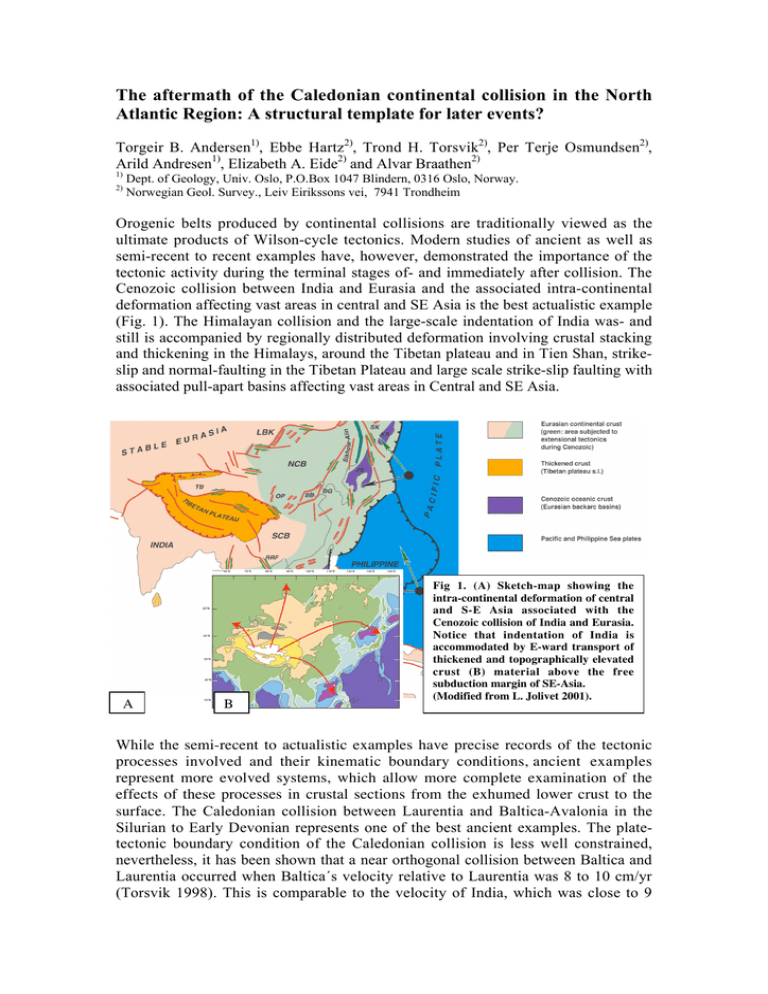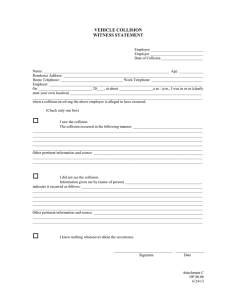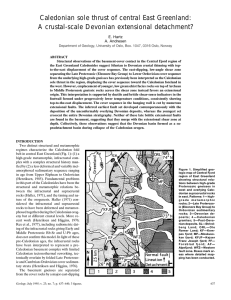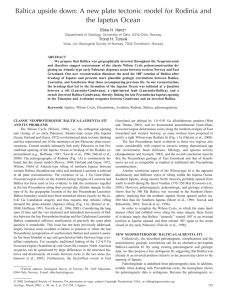The aftermath of the Caledonian continental collision in the North
advertisement

The aftermath of the Caledonian continental collision in the North Atlantic Region: A structural template for later events? Torgeir B. Andersen1), Ebbe Hartz2), Trond H. Torsvik2), Per Terje Osmundsen2), Arild Andresen1), Elizabeth A. Eide2) and Alvar Braathen2) 1) 2) Dept. of Geology, Univ. Oslo, P.O.Box 1047 Blindern, 0316 Oslo, Norway. Norwegian Geol. Survey., Leiv Eirikssons vei, 7941 Trondheim Orogenic belts produced by continental collisions are traditionally viewed as the ultimate products of Wilson-cycle tectonics. Modern studies of ancient as well as semi-recent to recent examples have, however, demonstrated the importance of the tectonic activity during the terminal stages of- and immediately after collision. The Cenozoic collision between India and Eurasia and the associated intra-continental deformation affecting vast areas in central and SE Asia is the best actualistic example (Fig. 1). The Himalayan collision and the large-scale indentation of India was- and still is accompanied by regionally distributed deformation involving crustal stacking and thickening in the Himalays, around the Tibetan plateau and in Tien Shan, strikeslip and normal-faulting in the Tibetan Plateau and large scale strike-slip faulting with associated pull-apart basins affecting vast areas in Central and SE Asia. A B Fig 1. (A) Sketch-map showing the intra-continental deformation of central and S-E Asia associated with the Cenozoic collision of India and Eurasia. Notice that indentation of India is accommodated by E-ward transport of thickened and topographically elevated crust (B) material above the free subduction margin of SE-Asia. (Modified from L. Jolivet 2001). While the semi-recent to actualistic examples have precise records of the tectonic processes involved and their kinematic boundary conditions, ancient examples represent more evolved systems, which allow more complete examination of the effects of these processes in crustal sections from the exhumed lower crust to the surface. The Caledonian collision between Laurentia and Baltica-Avalonia in the Silurian to Early Devonian represents one of the best ancient examples. The platetectonic boundary condition of the Caledonian collision is less well constrained, nevertheless, it has been shown that a near orthogonal collision between Baltica and Laurentia occurred when Baltica´s velocity relative to Laurentia was 8 to 10 cm/yr (Torsvik 1998). This is comparable to the velocity of India, which was close to 9 cm/yr, during the initial stages of the Himalayan collision. Other important similarities between the two belts are the size of continental Baltica and India, the double polarity of the thrust stracking, evidence for extreeme crustal thickening and the scales of the frontal thrust-belts. The exposed Scandinavian segment of the Caledonides is approximately 1750 km, whereas the Himalayan thrust front on India is approximately 2200 km between the eastern and the western syntaxes (Fig. 2) Fig. 2. The Scandinavian and East Greenland Caledonides in a tight Late-Silurian to Early Devonian reconstruction projected onto present day Himalay-Tibetean Plateau topography. The most important difference appears to be the duration of continental convergence, which in the case of the Caledonides was approximately 30 m.yr. as opposed to the ca 55 m.yr. in case of the Himalayas. Studies of the Caledonides of the North-Atlantic region have revealed that the structure of the orogen only can be understood in light of tectonic processes which outlasted the initial Scandian collision by as much as ca. 100 million years. Moreover, the structure in the exposed parts of the hinterland on both sides of the North-Atlantic and consequently also in the stretched and thinned basement of the shelf areas, are dominated by the late to post-orogenic structures rather than those produced during the collision itself. These include large exposed areas characterized by late to postcollisional high-grade ductile fabrics (cf. Western Gneiss Complex of SW Norway and the allochthonous basement/cover nappes in the Fjord Region of E-Greenland), localized ductile shear fabrics along major detachment- and strike-slip zones and high-level brittle faults which in most cases have been reactivated repeatedly (c.f. the Møre Trøndelag Fault Complex). These observations demonstrate the fundamental nature of the processes related to late and early post-orogenic tectonics. Depending on the plate-tectonic boundary conditions such processes include: [1] Indentation and regional crustal thickening, [2] Large-scale strike-slip and escape tectonics; [3] Major vertical movements accompanied by exhumation of high- and ultra-high-pressure rocks; [4] Formation of penetrative fabrics related to late- and post-collisional extension and accompanied by formation of sedimentary basins. BALTICA LAURENTIA E-AVALONIA Fig. 3. A schematic maximum tight-fit reconstruction for the Scandian collison taking into consideration the crustal thickening as documented by high- and ultra-high metamorphic complexes in Norway and Greenland. Palaeozoic sinistral strike-slip as well as post-orogenic extension of the shelf areas have been removed. This has particular significance to the areas outboard of the exposed high- and ultra-high pressure rocks shown with shaded ellipses in Greenland and Norway, where the shelf areas presently are particularly wide (see Fig. 4) In both the Scandinavian and Greenland Caledonides it has been demonstrated that major re-structuring of the collisional infra-structure related to points [2]; [3] and [4] occurred in the interior of the orogen throughout the Devonian. The main effects were, exhumation of HP and UHP rocks, crustal thinning on major detachments and normal faults; basin formation and a large-scale orogen-parallel strike-slip (transtension?) tectonics. The sinistral strike-slip with releasing and restraining bends apparently affected the entire orogenic belt from the British sector to Svalbard (Fig. 3). The Mid to Late Devonian extension and crustal thinning in parts of Greenland was dramatic and resulted in a high heat-flow, magmatism and a thermally weakened crust (Hartz et al. 2000). Evidence for indentation and regional crustal thickening of a scale similar to that observed north of the Himalayan orogen in central Asia is currently not documented. It is likely that indentation of Baltica came to a halt already in the Lower Devonian because the trailing, free margins of Baltica developed into active margins soon after Iapetus had closed; hence there was no driving force for continued convergence (Fig. 4). The “free” Herzynian and Uralian margins of BalticaAvalonia entered subduction zones with polarity away from Baltica-Avalonia. It is suggested that the free margins were important elements that permitted and perhaps even drove large scale relative motions across the mountain belt. Fig. 4. A) Pre-breakup reconstruction modified from Mosar et al. (2002), showing the large and highly extended shelf-areas (magnetic anomaly map) adjacent to Caledonian high-grade areas onshore. Areas affected by late Caledonian high- and ultra-high pressures are shown as shaded areas. The red arrows show the principal directions of extension in the Hanging walls of extensional detachments in Greenland and Scandinavia. B) A 400 Ma (Emsian) reconstruction from Torsvik & Cox (2001). Notice that the ”free” Uralian and Herzynian margins of Baltica are subduction margins with polarity away from the continent. There is apparently no plate-tectonic driving force that could sustain convergence between Baltica and Laurentia. The Lower to Middle Devonian is consequently a time during which extension and major strike-slip movements dominated the mountain belt. In conclusion: (1) Late- to post-orogenic processes produce fundamental crustal structures. (2) Collapse-related structures rather than those produced by collision dominate the hinterland of orogenic belts and provide the structural template for later events. (3) The late-to post-orogenic collapse structures are particularly important as a template for renewed extension and rifting that affected the N-Atlantic region. For these reasons, it is critical to establish the Late Paleozoic structural framework on the East Greenland and Mid-Norway conjugate margins, in order to place both kinematic and precise time constraints on subsequent, basin-controlling tectonic activity.







